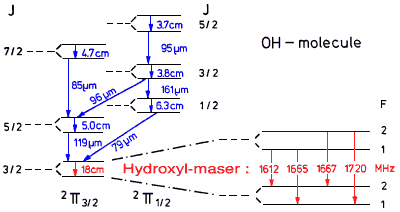NATURALLY OCCURING MICROWAVE LASERS
Javan (1958) predicted that negative absorption may eventually be
discovered radioastronomy. Seven years later the Radio Astronomy Group led by
Professor H Weaver (1965, 1968) at Berkeley California discovered radio emissions at 1670 MHz
coming from OH molecules near stars which can excite a population inversion by
radiation or other energy mechanisms.
Today hundreds of
maser
transitions are known in more than 36 molecules.

Energy level diagram depicting the 18 cm microwave transition and its
hyperfine structure.
To demonstrate amplified spontaneous emission, the astronomers came up
with the following evidence :
LINE RATIO EVIDENCE
The emission from the Hydroxyl molecule at 18 cm wavelength is composed
of four hyperfine lines at 1612, 1665, 1667 and 1720 MHz (see diagram).
Normally the line ratio for a gas in thermodynamic equilibrium is 1:5:9:1,
however the observed intensity ratios were different and even varied over time.
LINE WIDTH and LINE INTENSITY EVIDENCE
A paradoxical situation occurs if the gas was assumed in thermodynamic
equilibrium : The emission profiles of the OH lines as a function
of wavelength indicated a Doppler temperature of 50 K, however the emission
intensity was so strong that they would correspond to a source temperature
of several thousand trillion degrees Kelvin !
POINT SOURCE EMISSION EVIDENCE
The emission originates from extremely narrow point sources or highly
collimated beams.
POLARIZATION EVIDENCE
The emission lines were polarized in a particular way, which depended
on time and which could not possibly have been produced by spontaneous emission.
CONCLUSION
Based on these facts the radio astronomers conclude that the microwaves are
produced from amplification by stimulated emission of radiation from an inverted
population.
There is another review of the history of
masers written in a popular magazine for a more general audience.
REFERENCES
- Megamasers or megawrong ?
- Cook,A.H.: 1966, Nature, 210, 611.
- Javan,A. : 1958, Bull.Am.Phys.Soc., Ser. 2 3, 213.
- Litvak,M.M., McWhorter,A.L., Meeks,M.L., Zieger,H.J.: 1966, Phys.Rev.Lett. 17, 821.
- Perkins,F., Gold,T., Salpeter,E.E.: 1966, Astrophys.J. 145, 361.
- Weaver,H., Williams,D.R., Nannilou Dieter,H., Lum,T.W.: 1965, Nature 208, 29.
- Weaver,H., Nannilou Dieter,H., Williams,D.R.: 1968, Astrophys.J.Supp. 16, 10, 146, 219.
-
Gaume,R.A., Wilson,T.L., Johnston,K.J.: 1996, ApJ., 457, L47.
Non-LTE Effects in Ammonia (maser)
-
Torrelles, et al. 1996, ApJ., 457, L107.
Cepheus A HW2 jet and H2O masers
-
Sjouwerman,L.O.: 1996, ApJ., 461, L41.
OH Counterparts for HO Masers
-
Tsuboi,M., Ohta,E., Kasuga,T., Murata,Y., Handa,T.: 1996, ApJ., 461, L107.
SiO Maser Emission from Orion-KL IRc2
-
Maoz,E.: 1995, ApJ., 455, L131.
Masers in NGC 4258 ?
-
Zhang,Q., Ho,P.T.P.:1995, ApJ., 450, L63.
Ammonia Maser in Molecular Outflow toward W51
(VLA GIF)
-
Neufeld,D.A., Maloney,P.R.: 1995, ApJ., 447, L17.
Mass Accretion Rate through Disk in NGC 4258 (masers discovered)
-
Maotz,E.: 1995, ApJ., 447, L91.
Alternatives to Massive Black Hole in NGC 4258 (based on masers)
-
Dust Grains and Water Maser Luminosity
Maser Catalogs
Maser abstracts
Other maser related web site
- Molecular Spectroscopy (JPL)
- Methanol maser survey. Mount pleasant Radio Observatory
-
VLA Spectral Line Observations of the HII Complex G34.3+0.2
by Fey,A.L., Gaume,R.A., Nedoluha,G.E., Claussen,M.J.
- David Legge's, student - methanol masers
- Methanol masers
- radio astronomy news - maser detector
- JPL memorandums (go up one directory and check)
- JPL SPACE VLBI PROJECT
- VSOP Survey Maser Source List
- VSOP maser survey candidate list
- Arcetri H2O Maser catalog
- SiO Maser Survey of the Galactic Bulge IRAS Sources: I. the 7(deg)
- Gabriel Hickel (grad student) - W51 H2O maser
- NGC 4258 maser source
- ESO Preprints - SiO maser from symbiotic miras
- NASA Thesaurus - maser
- MASER - OH Cross Sections
- Mark von Bibra Grad student working on methanol masers
- 26m Telescope Report - DRAO/HIA - new methanol masers discovered
- Plasma Maser ?
- E.Scalise Jr - Time evolution of W51 Maser Source (H2O)
- The UC HII Survey and methanol maser emission
- New object types on simbad (maser etc...
-
NEWSLETTER OF CHEMICALLY PECULIAR RED GIANT STARS June 16, 1994,
Habing,H.J. (LEIDEN OBSERVATORY) - maser stars !!
(see Astron. and Astrophysics Review article on : Stars and Circumstellar OH Masers)
- Orion(KL) and Orion(1.5S) maser sources
(from
Douglas McGonagle Ph.D. thesis on interstellar molecules
- David Van Blerkom Graduate student - SiO masers in stars
- VLBA Observations of U Her - OH circumstellar maser
Diagram from p.58 of 'Physics of The Galaxy and Interstellar Medium'
Laser History

